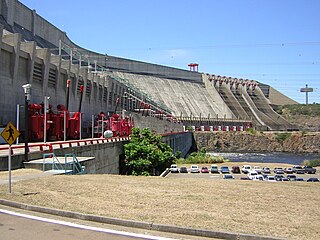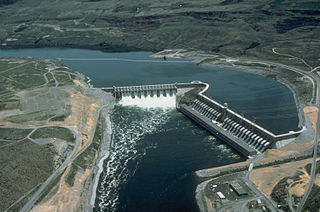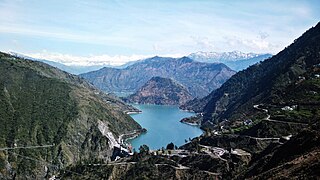
The 2009 Ecuador electricity crisis was caused by a severe drought that depleted water levels at hydroelectric plants. Ecuador experienced rolling blackouts for two to six hours per day that lasted from November 2009 until January 2010.

The 2009 Ecuador electricity crisis was caused by a severe drought that depleted water levels at hydroelectric plants. Ecuador experienced rolling blackouts for two to six hours per day that lasted from November 2009 until January 2010.
The electricity crisis arose from Ecuador's worst drought in 40 years, which began in September 2009. [1] [2] Government experts attributed the drought to the El Niño phenomenon. [2] Because of the drought, water levels at the Paute River dam—which normally supplies 40% of Ecuador's power—were extremely low. [1] The reservoir's water level is normally 1,991 meters above sea level, but on November 10 was only 1,968 meters above sea level. [1] The minimum level is 1,965 meters. [1] As of November 11, only two of the dam's 10 turbines were functioning. [1] Normally, the dam can supply up to 1,000 megawatts (MW), but the dam's output was only 200 MW on this day. [1]
Beginning November 5, rolling blackouts took place across Ecuador for two to six hours per day. [3] Government officials also urged citizens to conserve energy. [1] Economic losses from the blackouts are estimated to be in the tens of millions of dollars; factory output slowed, and storage of perishables was disrupted. [2]
On November 6, the government declared an emergency in the power sector, which was expected to "allow the Finance Ministry to seek to guarantee fuel imports for thermoelectric plants". [3] The government also agreed to purchase additional electricity from Peru and Colombia. [4] Government officials aimed to end power rationing before Christmas. [4]
The power crisis led to criticism of the Correa administration's management of the power sector as water levels of the reservoirs became depleted. [2]
In mid-January 2010, the blackouts were "suspended indefinitely", [5] following increased water levels and the acquisition of several generators. In February, Ecuador stopped the import of electricity from Colombia and Peru.[ citation needed ]

The Kariba Dam is a double curvature concrete arch dam in the Kariba Gorge of the Zambezi river basin between Zambia and Zimbabwe. The dam stands 128 metres (420 ft) tall and 579 metres (1,900 ft) long. The dam forms Lake Kariba, which extends for 280 kilometres (170 mi) and holds 185 cubic kilometres (150,000,000 acre⋅ft) of water.

The Itaipu Dam is a hydroelectric dam on the Paraná River located on the border between Brazil and Paraguay. It is the third largest hydroelectric dam in the world, and holds the 45th largest reservoir in the world.

Hydroelectricity, or hydroelectric power, is electricity generated from hydropower. Hydropower supplies 15% of the world's electricity, almost 4,210 TWh in 2023, which is more than all other renewable sources combined and also more than nuclear power. Hydropower can provide large amounts of low-carbon electricity on demand, making it a key element for creating secure and clean electricity supply systems. A hydroelectric power station that has a dam and reservoir is a flexible source, since the amount of electricity produced can be increased or decreased in seconds or minutes in response to varying electricity demand. Once a hydroelectric complex is constructed, it produces no direct waste, and almost always emits considerably less greenhouse gas than fossil fuel-powered energy plants. However, when constructed in lowland rainforest areas, where part of the forest is inundated, substantial amounts of greenhouse gases may be emitted.

The Simón Bolívar Hydroelectric Plant, also Guri Dam, previously known as the Raúl LeoniHydroelectric Plant, is a concrete gravity and embankment dam in Bolívar State, Venezuela, on the Caroni River, built from 1963 to 1969. It is 7,426 metres long and 162 m high. It impounds the large Guri Reservoir with a surface area of 4,250 square kilometres (1,641 sq mi).

Nagarjuna Sagar Dam is a masonry dam across the Krishna River at Nagarjuna Sagar which straddles the border between Palnadu district in Andhra Pradesh and Nalgonda district in Telangana. The dam provides irrigation water to the districts of Krishna, Guntur, Palnadu, Prakasam and parts of West Godavari districts of Andhra Pradesh and also Nalgonda, Suryapet, Khammam, Bhadradri Kothagudem districts of Telangana. It is also a source of electricity generation for the national grid.

Hartwell Dam is a concrete and embankment dam located on the Savannah River at the border of South Carolina and Georgia, creating Lake Hartwell. The dam was built by the U.S. Army Corps of Engineers between 1955 and 1962 for the purposes of flood control, hydropower and navigation. The concrete and earthen structure spans 15,840 feet (4,828 m). The concrete section is 1,900 feet (579 m) long and rises 204 feet (62 m) above the riverbed at its apex. The Hartwell Dam currently produces 468 million KWh of electricity annually, has prevented over $40 million in flood damage since completion and also provides recreation, water quality, water supply, along with fish and wildlife management.

Run-of-river hydroelectricity (ROR) or run-of-the-river hydroelectricity is a type of hydroelectric generation plant whereby little or no water storage is provided. Run-of-the-river power plants may have no water storage at all or a limited amount of storage, in which case the storage reservoir is referred to as pondage. A plant without pondage is subject to seasonal river flows, so the plant will operate as an intermittent energy source. Conventional hydro uses reservoirs, which regulate water for flood control, dispatchable electrical power, and the provision of fresh water for agriculture.
Brazil has the largest electricity sector in Latin America. Its capacity at the end of 2021 was 181,532 MW. The installed capacity grew from 11,000 MW in 1970 with an average yearly growth of 5.8% per year. Brazil has the largest capacity for water storage in the world, being dependent on hydroelectricity generation capacity, which meets over 60% of its electricity demand. The national grid runs at 60 Hz and is powered 83% from renewable sources. This dependence on hydropower makes Brazil vulnerable to power supply shortages in drought years, as was demonstrated by the 2001–2002 energy crisis.
Electricity in Pakistan is generated, transmitted and distributed by two vertically integrated public sector companies, first one being Water and Power Development Authority (WAPDA) responsible for the production of hydroelectricity and its supply to the consumers by electricity distribution companies (DISCOS) under the Pakistan Electric Power Company (PEPCO) being the other integrated company. Currently, there are 12 distribution companies and a National Transmission And Dispatch Company (NTDC) which are all in the public sector except Karachi Electric in the city of Karachi and its surrounding areas. There are around 42 independent power producers (IPPs) that contribute significantly in electricity generation in Pakistan.
Energy rationing primarily involves measures that are designed to force energy conservation as an alternative to price mechanisms in energy markets. Because of its economic consequences energy rationing is used as method of last resort, often at times of emergency such as during an energy crisis.

The Chamera Dam impounds the River Ravi and supports the hydroelectricity project in the region. It is located near the town of Dalhousie, in the Chamba district in the state of Himachal Pradesh in India. The reservoir of the dam is the Chamera Lake. Large part of its reservoir lies in Salooni sub-division of Chamba.

The utility electricity sector in Bangladesh has one national grid operated by Power Grid Company of Bangladesh with an installed capacity of 25,700 MW as of June 2022. Bangladesh's energy sector is not up to the mark. However, per capita energy consumption in Bangladesh is considered higher than the production. Electricity was introduced to the country on 7 December 1901.

The Gilgel Gibe III Dam is a 250m high roller-compacted concrete dam with an associated hydroelectric power plant on the Omo River in Ethiopia. It is located about 62 km (39 mi) west of Sodo in the Southern Nations, Nationalities, and Peoples' Region. Once fully commissioned, it will be the third largest hydroelectric plant in Africa with a power output of about 1,870 Megawatt (MW), thus more than doubling Ethiopia's total installed capacity from its 2007 level of 814 MW. The Gibe III dam is part of the Gibe cascade, a series of dams including the existing Gibe I dam and Gibe II power station as well as the planned Gibe IV and Gibe V dams. The existing dams are owned and operated by the state-owned Ethiopian Electric Power, which is also the client for the Gibe III Dam.

Energy in Lebanon is characterized by a heavy reliance on imported fuels, which has led to significant challenges in ensuring a stable and sufficient supply of electricity. The country’s energy sector has been severely affected by a combination of internal political instability, external conflicts, and systemic corruption. The reliance on imported energy, coupled with rising demand and frequent infrastructure failures, has led to an ongoing energy crisis. This crisis has been further exacerbated by the destructive effects of military conflicts involving Hezbollah, particularly the wars against Israel and the war in Syria, which have strained the country's infrastructure and economy.
The 1992 Colombian energy crisis was a crisis of the Colombian energy sector during the presidency of César Gaviria, from May 2, 1992, to February 7, 1993, caused by El Niño. El Niño caused droughts across much of the country, which lowered reservoir levels at many of its principal hydroelectric dams and a further crisis within the state public services company, Interconexión Eléctrica, S.A. (ISA).

The Bissorte Dam is a gravity dam in the Maurienne Valley, in Savoie, France, about 7 km (4.3 mi) east of Valmeinier. It was built from 1930 to 1935 to supply a hydroelectric plant capable of generating 75 megawatts (MW) of power.
The 2016 Tasmanian energy crisis was an ongoing energy storage situation in the state of Tasmania, Australia in 2016. Two years of high volumes of energy exported to Victoria via the Basslink HVDC cable, followed by low rainfall, and a fault which rendered the cable inoperable, resulted in record low storage levels in Tasmania's hydro-electric system. This resulted in a number of contingency plans to be enacted by Hydro Tasmania and the Hodgman Government.
Venezuela has experienced a marked deficit in the generation of electrical energy. The immediate cause of the energy crisis was a prolonged drought that caused the water in the reservoir of the Simón Bolívar Hydroelectric Plant to reach very low levels. Although various measures were taken to overcome the crisis, one of the most controversial was the implementation of a program of electrical rationing throughout the country, except in the capital Caracas, which was ultimately officially suspended in June 2010, due to the recovery of reservoirs due to the rains, and not to interrupt the transmission of the 2010 FIFA World Cup. Power cuts have continued to occur in the interior of the country, although with less frequency and duration, this time driven by failures in other parts of the system. The situation of "electrical emergency" decreed by the government on 21 December 2009 was suspended on 30 November 2010; however, on 14 May 2011, after the country experienced two national blackouts, the government of Hugo Chávez announced a temporary rationing plan and acknowledged that the electricity system continued to face "generation weaknesses" that they did not expect to surpass until end the year.
The 2019 Sri Lanka electricity crisis was a crisis which happened nearly a month from 18 March to 10 April 2019 faced by Sri Lanka caused by a severe drought that depleted water levels at hydroelectric plants. Sri Lanka experienced rolling blackouts for three to five hours per day except on Sundays in all parts of the island nation at different time schedules that started from 24 March 2019 to present. This is regarded as one of the worst blackouts confronted in Sri Lanka since 2016 and the longest ever blackout recorded in history of the country. However it was revealed that the main electricity providing institution Ceylon Electricity Board had restricted the power supply to almost all regions of the country without proper prior notice and implemented a time schedule unofficially from 24 March 2019. However the Ministry of Power and Renewable Energy revealed that it didn't grant and approve permission to CEB to impose power cuts.
The 2023-2024 Ecuador electricity crisis was caused by a severe drought that depleted water levels at hydroelectric plants and a lack of capacity buildup. Ecuador experienced rolling blackouts for up to 14 hours per day in the fall crisis of 2024. Researches describe fall 2023 and spring 2024 crises as separate events. The President of Ecuador Daniel Noboa had announced on 10 December, 2024 that the outages will end on December 20.